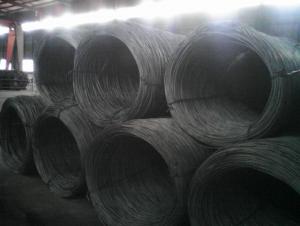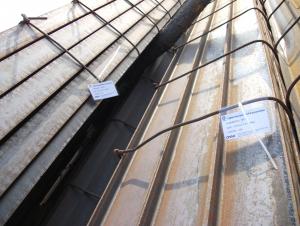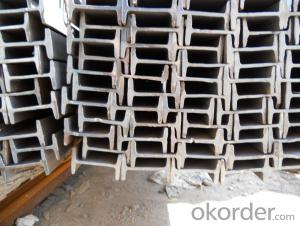Hot Rolled Steel Wide Flange H Beam
- Loading Port:
- China Main Port
- Payment Terms:
- TT or LC
- Min Order Qty:
- 100MT m.t.
- Supply Capability:
- 10000MT/month m.t./month
OKorder Service Pledge
OKorder Financial Service
You Might Also Like
Specifications of Hot Rolled Steel Wide Flange H Beam
1. Standard: JIS G3101, SS400(1987),GB700-88, Q235B,EN10034-1993 / EN10025-2004,
HEA100-HEA500,HEB100-HEB500
2. Grade: Q235, SS400 or Equivalent
3. Length: 6m,10m, 12m as following table
4. Invoicing on theoretical weight or actual weight as customer request
5.Payment: TT or L/C
6. Sizes:
SIZE(mm) | DIMENSION(kg/m) |
100*100 | 16.9 |
125*125 | 23.6 |
150*75 | 14 |
150*150 | 31.1 |
148*100 | 20.7 |
198*99 | 17.8 |
200*100 | 20.9 |
248*124 | 25.1 |
250*125 | 29 |
300*150 | 36.7 |
298*149 | 32 |
200*200 | 49.9 |
294*200 | 55.8 |
346*174 | 41.2 |
350*175 | 49.4 |
244*175 | 43.6 |
175*175 | 40.4 |
294*200 | 55.8 |
298*201 | 64.4 |
346*174 | 41.2 |
350*175 | 49.4 |
400*200 | 65.4 |
396*199 | 56.1 |
450*200 | 74.9 |
446*199 | 65.1 |
340*250 | 78.1 |
500*200 | 88.1 |
300*150 | 36.7 |
Usage & Applications of Specifications of Hot Rolled Steel Wide Flange H Beam
Commercial building structure ;Pre-engineered buildings; Machinery support structure; Prefabricated structure; Medium scale bridges; Ship-building structure. etc.
Packaging & Delivery of Hot Rolled Steel Wide Flange H Beam
1. Packing: it is nude packed in bundles by steel wire rod
2. Bundle weight: not more than 3.5MT for bulk vessel; less than 3 MT for container load
3. Marks:
Color marking: There will be color marking on both end of the bundle for the cargo delivered by bulk vessel. That makes it easily to distinguish at the destination port.
Tag mark: there will be tag mark tied up on the bundles. The information usually including supplier logo and name, product name, made in China, shipping marks and other information request by the customer.
If loading by container the marking is not needed, but we will prepare it as customer request.
4. Transportation: the goods are delivered by truck from mill to loading port, the maximum quantity can be loaded is around 40MTs by each truck. If the order quantity cannot reach the full truck loaded, the transportation cost per ton will be little higher than full load.
5. Delivered by container or bulk vessel
Production flow of Hot Rolled Steel Wide Flange H Beam
Material prepare (billet) —heat up—rough rolling—precision rolling—cooling—packing—storage and transportation


- Q: What are the safety considerations when working with steel H-beams?
- When handling steel H-beams, it is important to consider several safety factors. 1. Personal Protective Equipment (PPE): It is crucial to wear the necessary PPE to protect yourself from potential dangers. This may include safety glasses, steel-toed boots, gloves, and a hard hat. 2. Manual Handling: Proper lifting techniques are necessary to avoid strain or injury when dealing with heavy steel H-beams. It is advisable to use mechanical aids like cranes or forklifts for lifting and moving the beams. If manual lifting is required, ensure you have a team of workers and use proper techniques like bending at the knees and keeping the back straight. 3. Stability and Support: Ensuring the stability and proper support of steel H-beams is important. Implement appropriate bracing or shoring techniques to prevent accidental collapse or movement. 4. Edge and Surface Hazards: Steel H-beams may have sharp edges or rough surfaces that can cause cuts, abrasions, or punctures. Exercise caution when handling them and use protective measures like gloves or padding to minimize the risk of injury. 5. Welding and Cutting: If welding or cutting steel H-beams is necessary, ensure adequate ventilation and use respiratory protection to avoid inhaling fumes or gases. Follow correct welding and cutting procedures and be mindful of potential sparks, heat, and fire hazards. 6. Fall Hazards: When working at heights with steel H-beams, such as during installation or construction, it is essential to use fall protection equipment like safety harnesses or guardrails. Always receive proper training and adhere to safety protocols when working at elevated heights. 7. Awareness of Surroundings: Steel H-beams are commonly used in construction or industrial settings that may have other potential hazards like heavy machinery, moving vehicles, or falling objects. Stay alert and be aware of your surroundings to prevent accidents. Overall, prioritizing safety is crucial when working with steel H-beams. By following appropriate safety protocols, using the necessary PPE, and being mindful of potential hazards, a safe working environment can be ensured.
- Q: How do steel H-beams contribute to daylighting in buildings?
- Steel H-beams play a crucial role in daylighting in buildings by providing structural support while allowing for larger and more expansive windows. Daylighting refers to the use of natural light to illuminate the interior spaces of a building, reducing the need for artificial lighting and creating a more sustainable and pleasant environment. With their strong load-bearing capabilities, steel H-beams can span long distances and support heavy loads, making it possible to have larger window openings. These windows can be strategically placed on exterior walls or even in the roof, allowing natural light to flood into the building's interior. The use of steel H-beams in construction also enables architects to design buildings with open floor plans and soaring ceilings. This architectural freedom allows for the creation of atriums, skylights, and other light wells that further enhance daylight penetration. Moreover, steel H-beams are incredibly durable and resistant to deformation, ensuring that the structural integrity of the building is maintained while maximizing the amount of natural light that enters the space. This is especially important in areas prone to earthquakes or high winds. In addition to their structural benefits, steel H-beams are versatile in terms of design and aesthetics. They can be incorporated into various architectural styles, allowing for innovative and visually appealing building designs that prioritize daylighting. Overall, steel H-beams contribute significantly to daylighting in buildings by providing the necessary strength and support for larger windows, allowing for creative architectural designs, and ensuring the durability of the structure. By harnessing natural light, buildings can reduce energy consumption, improve occupants' well-being, and create more sustainable and inviting spaces.
- Q: How to control the welding deformation made of H steel
- H steel is a new type of economical construction steel. H type steel cross section shape is reasonable in economy, good mechanical properties, rolling each point on the extended section is uniform, small internal stress, compared with the ordinary beam, a section modulus, light weight, saving advantages of metal, can make the building structure to reduce 30-40%; and because of its inner and outer legs parallel leg end is right, assembled into components, welding, riveting work can save up to 25%. Often used in large capacity requirements, large cross section stability, such as buildings, high-rise buildings, as well as bridges, ships, lifting transport machinery, equipment foundation, support, foundation piles.
- Q: How do steel H-beams perform in heavy snow loads?
- Due to their exceptional strength and load-bearing capacity, steel H-beams are widely utilized in the construction industry. They excel particularly well in handling heavy snow loads. The H-beam design allows for the even distribution of weight along its length, making it ideal for withstanding the accumulation of snow. The unique shape of the H-beam provides a high moment of inertia, which helps minimize deflection and ensures structural stability in the face of heavy snow loads. Moreover, the high tensile strength of steel H-beams enables them to resist bending and deformation caused by the weight of the snow. This strength guarantees that the beams can endure the pressure exerted by the snow without compromising the integrity of the building or infrastructure. In addition, steel H-beams exhibit remarkable durability and resistance to corrosion, making them suitable for long-term use in areas prone to heavy snowfall. The steel's ability to withstand harsh weather conditions, including extreme cold and moisture, guarantees that the H-beams retain their structural properties even in snowy environments. In summary, steel H-beams are an excellent choice for handling heavy snow loads. Their strength, load-bearing capacity, and durability make them a reliable option for supporting structures under the weight of snow. They provide stability and safety in areas that experience heavy snowfall.
- Q: Are steel H-beams resistant to chemicals or corrosive substances?
- Yes, steel H-beams are generally resistant to chemicals and corrosive substances due to their composition and protective coatings. However, the level of resistance can vary depending on the specific type of steel and the nature of the chemical or corrosive substance involved. It is important to consider the specific application and consult with experts to ensure proper corrosion protection measures are in place.
- Q: What are the different design codes for steel H-beams?
- The different design codes for steel H-beams include the American Institute of Steel Construction (AISC) code, European Standard (EN) code, Japanese Industrial Standards (JIS) code, and the British Standards (BS) code. These codes provide guidelines and specifications for the design, fabrication, and use of steel H-beams in various structural applications.
- Q: H steel compared with ordinary steel in the end what are the advantages and disadvantages?
- H section steel is a kind of economical and economical cutting surface profile (other cold bending thin wall steel, pressed steel plate, etc.). Because of the reasonable cross-section shape, they can make steel more effective and improve the bearing capacity. Unlike ordinary I-beam, the flange of H steel is widened, and the inner and outer surfaces are usually parallel so that it is easy to connect with high strength bolts and other components. Its size constitutes a reasonable series, complete model, easy to design and use. (in addition to crane girders)
- Q: What are the design considerations for steel H-beams in earthquake-prone regions?
- Design considerations for steel H-beams in earthquake-prone regions primarily focus on ensuring the structural integrity and resistance to seismic forces. Here are some key considerations: 1. Material selection: The choice of steel grade is crucial to withstand seismic forces. High-strength steel, such as ASTM A992 or A572 Grade 50, is commonly used for H-beams in earthquake-prone areas due to its superior strength and ductility. 2. Beam size and shape: The dimensions of H-beams need to be carefully calculated to ensure sufficient load-carrying capacity and resistance to bending and buckling during seismic events. The beam's depth, flange width, and thickness are determined based on the expected loads and the building's seismic design requirements. 3. Connection design: The connections between H-beams and other structural elements must be designed to resist seismic forces effectively. Special attention is given to the moment connections at beam-column joints, as these areas are prone to concentrated forces during earthquakes. Strong, ductile connections, such as extended end-plate connections or moment-resisting frames, are often employed. 4. Ductility and redundancy: The design of H-beams in earthquake-prone regions emphasizes the need for ductility and redundancy. Ductility allows the steel members to deform and absorb energy during seismic events, while redundancy ensures that the structure can redistribute loads and maintain stability even if some elements fail. 5. Bracing and reinforcement: Proper bracing and reinforcement techniques are essential to enhance the overall stiffness and stability of H-beam structures in earthquake-prone areas. Lateral bracing systems, such as diagonal braces or shear walls, are commonly employed to reduce the lateral sway and increase resistance to seismic forces. 6. Seismic design codes and regulations: Compliance with local building codes and seismic design regulations is crucial in earthquake-prone regions. Designers need to be familiar with the specific requirements and guidelines provided in these codes to ensure the H-beam structures are adequately designed and constructed to withstand seismic events. 7. Seismic analysis and testing: Prior to construction, structural engineers perform detailed seismic analysis and testing to evaluate the behavior and response of H-beams under earthquake loading. This analysis helps determine the appropriate design parameters and identify potential weaknesses or areas of improvement. Overall, the design considerations for steel H-beams in earthquake-prone regions revolve around ensuring structural integrity, resistance to seismic forces, and compliance with relevant building codes. By employing these considerations, engineers can create robust and safe structures that can withstand the challenges posed by earthquakes.
- Q: Can steel H-beams be used in gymnasium structures?
- Certainly, gymnasium structures can incorporate steel H-beams. Thanks to their robustness and durability, steel H-beams are frequently employed in construction projects. They offer remarkable stability and support, rendering them ideal for expansive areas such as gymnasiums. Furthermore, steel H-beams can be readily tailored and fabricated to meet the precise design prerequisites of a gymnasium. They possess the ability to endure substantial loads and guarantee the essential structural integrity requisite for gymnasium structures.
- Q: Can steel H-beams be used for supporting highway or railway bridges?
- Certainly, steel H-beams are suitable for supporting highway or railway bridges. Due to their exceptional load-bearing capacity and structural strength, steel H-beams are extensively utilized in bridge construction. They offer a robust framework for constructing bridges that can endure heavy traffic loads and diverse environmental conditions. The H-shape of the beams permits superior load distribution, making them perfect for supporting vast spans and heavy loads commonly encountered in highway or railway bridges. Furthermore, steel H-beams are recognized for their durability, resilience, and resistance to corrosion, thus making them appropriate for long-term utilization in bridge construction. Moreover, steel H-beams are easily fabricated and installed, enhancing their appeal for bridge construction projects. By employing appropriate engineering design and construction techniques, steel H-beams can provide the necessary support and stability essential for safe and efficient transportation across highways or railways. Nevertheless, it is crucial to emphasize that engineers and architects must meticulously determine the specific design and dimensions of the steel H-beams based on the requirements of the bridge project, such as span length, load-bearing capacity, and projected traffic loads. Additionally, regular inspections and maintenance must be conducted to ensure the sustained safety and durability of the bridge structure.
1. Manufacturer Overview
| Location | Tangshan, China |
| Year Established | 2007 |
| Annual Output Value | Above US$ 80 Million |
| Main Markets | Mid East; Southeast aisa; korea |
| Company Certifications |
2. Manufacturer Certificates
| a) Certification Name | |
| Range | |
| Reference | |
| Validity Period |
3. Manufacturer Capability
| a) Trade Capacity | |
| Nearest Port | Tianjin; |
| Export Percentage | 20% - 25% |
| No.of Employees in Trade Department | 11-15 People |
| Language Spoken: | English; Chinese |
| b) Factory Information | |
| Factory Size: | Above 75,000 square meters |
| No. of Production Lines | 1 |
| Contract Manufacturing | OEM Service Offered; |
| Product Price Range | Average |
Send your message to us
Hot Rolled Steel Wide Flange H Beam
- Loading Port:
- China Main Port
- Payment Terms:
- TT or LC
- Min Order Qty:
- 100MT m.t.
- Supply Capability:
- 10000MT/month m.t./month
OKorder Service Pledge
OKorder Financial Service
Similar products
Hot products
Hot Searches
Related keywords




























